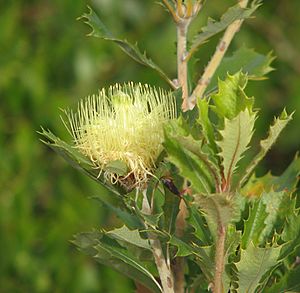Cactus dryandra facts for kids
Quick facts for kids Cactus dryandra |
|
|---|---|
 |
|
| Banksia anatona in Royal Botanic Gardens, Cranbourne | |
| Conservation status | |
| Scientific classification | |
| Genus: |
Banksia
|
| Species: |
anatona
|
| Synonyms | |
|
|
The Banksia anatona, also known as the cactus dryandra, is a type of flowering plant. It belongs to the Proteaceae plant family. This plant is special because it is only found naturally in Western Australia.
It is a tall, thin shrub that grows unusually large fruit pods. The Banksia anatona is only known to grow in one main place. Because of this, it is listed as Critically Endangered in Australia. The only known group of these plants is at risk of disappearing due to a plant disease called dieback.
What Does It Look Like?
The Banksia anatona is a shrub that usually has one main stem. It has short branches on its sides and can grow up to about 5 meters (16 feet) tall. Unlike many other plants in the Banksia group, it does not have a special woody base called a lignotuber. This means it cannot easily regrow from its base after a fire.
Its branches are covered with soft, tangled hairs. The leaves are shaped like a wedge, narrow at the bottom. They have a hairy stalk about 3 to 7 millimeters (0.1 to 0.3 inches) long. The leaf blade itself is about 30 to 70 millimeters (1.2 to 2.8 inches) long and 12 to 22 millimeters (0.5 to 0.9 inches) wide.
When the leaves are young, their top surface is hairy. But as they get older, they become smooth. The bottom surface of the leaves stays covered with tangled hairs. The edges of the leaves are wavy and have 10 to 12 jagged points on each side.
The flowers grow in a spike at the ends of the main branches or side branches. Each flower spike has about 170 tiny individual flowers. A part of the flower that holds the pollen is about 4 to 5 millimeters (0.16 to 0.20 inches) long. These flowers usually appear between January and June. After the flowers, the plant grows fruits that are shaped like eggs, narrow at the bottom. These fruits are about 24 millimeters (0.9 inches) long and are also hairy.
How It Got Its Name
Scientists first officially described this plant in 1996. A scientist named Alex George gave it the name Dryandra anatona. This description was published in a science journal called Nuytsia.
Later, in 2007, two other scientists, Austin Mast and Kevin Thiele, decided that all Dryandra plants should actually be part of the Banksia group. So, this plant's name changed to Banksia anatona.
The second part of its name, anatona, comes from ancient Greek words. 'Tónos' means "rope" or "chord," and 'ana-' means "up" or "upwards." This name describes how the plant grows tall and thin, like a rope reaching up.
Where It Lives
The Banksia anatona is only found in a small area within the Stirling Range National Park in the Esperance Plains region of Western Australia.
This plant is in danger from a plant disease called 'dieback.' This disease is caused by a tiny fungus-like organism, Phytophthora cinnamomi, that attacks plant roots. Luckily, a small group of these plants has also been planted on private land to help protect them.
The Banksia anatona grows in sandy soil on hillsides. It likes areas where many different types of native plants, called 'kwongan,' grow closely together.
Protecting This Plant
This plant is considered "Threatened Flora" by the Department of Environment and Conservation in Western Australia. The Australian Government also lists it as "critically endangered" under the Environment Protection and Biodiversity Conservation Act 1999. This means it is at very high risk of becoming extinct in the wild.
See also
 In Spanish: Banksia anatona para niños
In Spanish: Banksia anatona para niños


